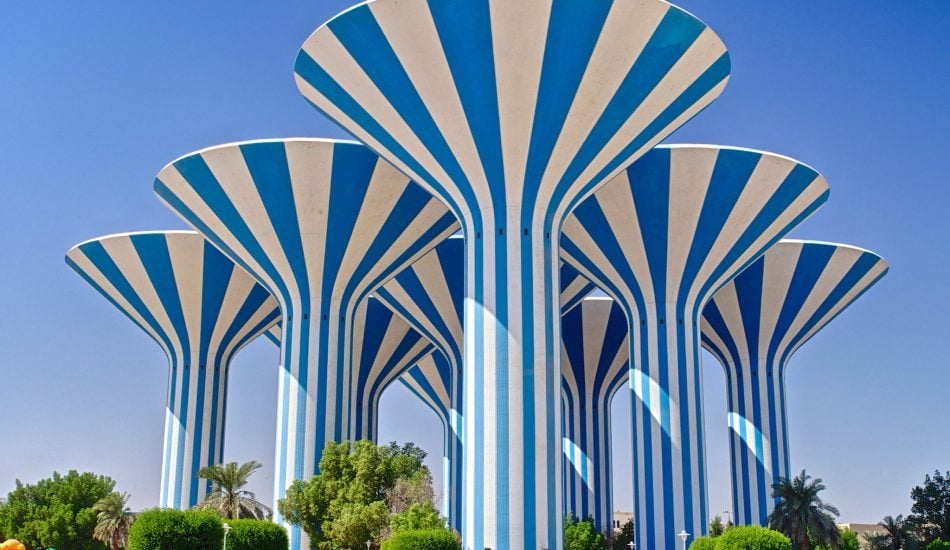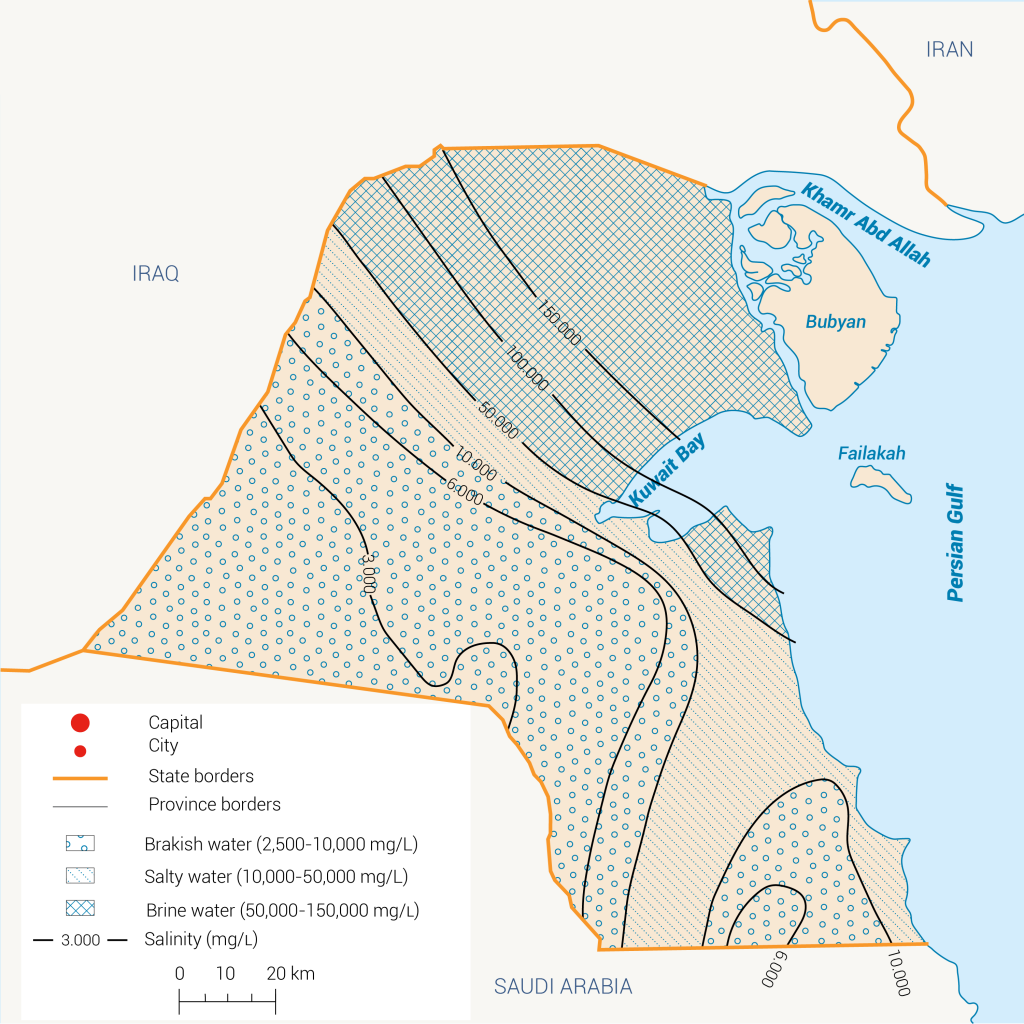
Water quality in Kuwait Bay
Many desalination plants, power plants, recreational facilities, hospitals and other urban and industrial facilities have been constructed along the coast of Kuwait Bay. Most of these facilities discharge their effluents directly into the bay, causing severe problems for the ecosystem.[1] Various contaminants are known to pollute the marine environment, including petroleum hydrocarbons, trace metals, nutrients, bacterial coliforms from sewage and brine from desalination plants.[2]
A total of 25% of untreated wastewater is discharged into the sea.[3] This wastewater contains a range of pathogens, including bacteria, parasites and viruses, and causes deoxygenated dead zones in the sea, accumulation of nitrous oxide and emissions of methane.[4] High concentrations of phosphate and nitrogen have been observed, especially in the Sulaibikhat Bay. These concentrations result in algae spread or eutrophication, which absorbs dissolved oxygen and results in reduction in water quality and the death of fish and important micro-organisms.[5]
The breakdown of the Mishref pumping station plant in 2009 worsened the conditions of the marine environment. The pumping station malfunctioned, resulting in the discharge of around 150,000 m3/d of untreated sewage directly into the sea over a 24-month period. As a result, beaches in a number of areas important for tourism and residential housing were impacted. Monitoring undertaken by the Kuwait Environment Public Authority during this period indicated that approximately 20 km of coastline were affected, with a reduction in water quality parameters (e.g. ammonia and phosphate elevated) and bacterial indicators exceeding permitted guidelines.[6]
In addition, desalination industries in Gulf countries, including Kuwait, return over 7 km3/yr of the brine to the Persian Gulf. This brine is usually warmer than receiving waters and contains contaminants such as biocides introduced to prevent biofouling. These can cause elevations of temperature (up to 5°C) and salinity (up to 4%) in the already warm and highly saline receiving water.[7]
Tap water quality
The desalinated water is pure and has low concentrations of dissolved salts and gases and a total alkalinity of less than 1 mg/L as CaCO3, which is not suitable for human use.[8] Therefore, the desalinated water is blended with brackish groundwater to produce drinking water that meets World Health Organization guidelines.[9]
A study conducted in 2015 to assess the quality of the tap water in Kuwait showed all physicochemical parameters to be within the standard guidelines. Minor variations were found while comparing the values of pH, TDS and electrical conductivity between tap and domestic bottled water. Water supply authorities need to consider periodical maintenance for the pipeline distribution network.[10]
Groundwater quality
Groundwater resources in Kuwait are mainly brackish or saline.[11] Brackish groundwater is located in the Kuwait Group and the Dammam Formation aquifers and has a salinity ranging from 4,000-9,000 mg/L and 3,000-6,000 mg/L, respectively.[12] The water quality variation in the Dammam Formation aquifer is presented in Map 1. Brackish groundwater is abstracted from the wellfields in Sulaibiya, Shagaya, Wafra, Um-Qadir and Atraf.[13] Table 1 displays the salinity level of the brackish groundwater from these wellfields.
Table 1: Salinity level of the brackish groundwater in Kuwait.[14]
| Fields | Salinity (mg/L) |
| Shagaya Fields - A | 3,250 |
| Shagaya Fields - B | 3,000 |
| Shagaya Fields - C | 2,800 |
| Shagaya Fields - D | 2,800 |
| Shagaya Fields - E | 4,200 |
| Sulaibiya Field | 4,000-5,000 |
| Um-Qadir Field | 3,700-4,100 |
| Wafra Field | 4,500-5,500 |
| Atraf Field | 4,000-4,500 |
[1] Al-Yamani, F, 2008. Importance of the freshwater influx from the Shatt al-Arab River on the Gulf marine environment. Protecting the Gulf’s Marine Ecosystems from Pollution, pp. 207-22.
[2] Al-Sarawi, H et al., 2015. Historic and contemporary contamination in the marine environment of Kuwait: An overview. Marine Pollution Bulletin, 100(2): 621-628.
[3] Aleisa, E and Alshayji, K, 2019. Analysis on reclamation and reuse of wastewater in Kuwait. Journal of Engineering Research, 7(1): 1-13.
[4] Corcoran, E et al., 2010. Sick Water? The Central Role of Wastewater Management in Sustainable Development. Birkeland Trykkeri AS, Norway: UNEP, UN HABITAT, GRID-Arenda.
[5] Aleisa, E and Alshayji, K, 2019. Analysis on reclamation and reuse of wastewater in Kuwait. Journal of Engineering Research, 7(1): 1-13.
[6] Ibid.
[7] Ibid.
[8] Al-Ruwaih, F et al., 2010. Quality of potable water in Kuwait. American Journal of Environmental Sciences 6(3): 260-267.
[9] Ibid.
[10] Assad, A, 2015. Quality of tap drinking water in Kuwait: Physicochemical characteristics. International Conference on Sustainable Mobility Applications, Renewables and Technology (SMART).
[11] First Biennial Update Report of the State of Kuwait, 2019. Environment Public Authority.
[12] Statistical Yearbook Water Edition 2019, 2020. Ministry of Electricity and Water.
[13] AlAli, E H, 2008. Groundwater history and trends in Kuwait. Sustainable Irrigation Management, Technologies and Policies II.
[14] Statistical Yearbook Water Edition 2019, 2020. Ministry of Electricity and Water.

